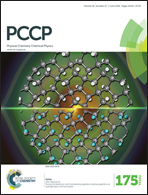Significant curvature effects of partially charged carbon nanotubes on electrolyte behavior investigated using Monte Carlo simulations†
Abstract
Carbon nanotubes and graphene are among the major nanomaterials in nanoscience and technology. Despite having π electrons, these nanocarbon allotropes have been simply considered as neutral in classical calculations. In this study, the effects of partial charges on graphene and curved interfaces on molecular adsorption were investigated using Monte Carlo simulations of N2 and NaCl aqueous solutions on graphene and carbon nanotubes. The simulated N2 adsorption behavior and adsorption potential on partially charged and non-charged graphene coincided with each other. The adsorption potentials suggested that partially charged graphene attracted Na ions and repelled Cl ions. However, those tendencies were not present in NaCl aqueous solutions on graphene. Conversely, in partially charged carbon nanotube models, a preference for Na ions and repulsion of Cl ions in the internal nanospaces were observed in the adsorption potentials using Monte Carlo simulations. Curved interfaces in the internal nanospaces of carbon nanotubes enhanced these properties, suggesting significant electrostatic interactions in a curved π-conjugated system.



 Please wait while we load your content...
Please wait while we load your content...